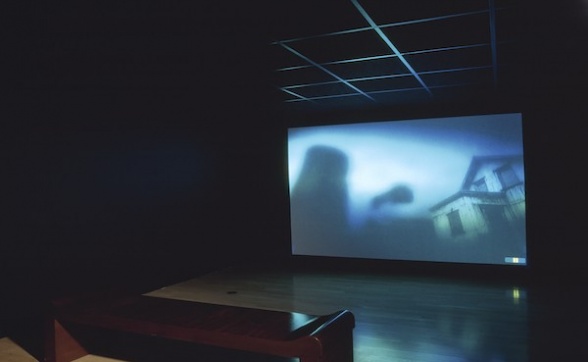Clare Langan
Clare Langan, (installation view), 2002
Clare Langan’s (b.1967, Dublin, UK) dramatic landscapes – tinged in shades of aquatic blue-greens, glowing in atmospheric sand tones and burning in volcanic reds – are the products of relatively primitive technology applied on location. In her film installations she continues to afford the luxury of using the ‘old-fashioned’ mechanical medium of film, shooting on 16mm stock, which is then transferred to DVD and projected. The artist deliberately refrains from the elaborate manipulation of images in post-production (except for some careful editing) that is today standard practice in both commercial as well as experimental film and video production, relying instead on the inherent sensuality of film.
Glass hour (2002) was the third part in Clare Langan’s post-apocalyptic trilogy that commenced with Forty Below (1999) and continued with Too dark for night (2001). The three films were shown together for the first time in the International 02. Having explored the natural wastelands of the Namibian desert and the landscapes of Iceland and Ireland, Glass hour (2002) added a third dimension to Langan’s exploration ‘of mankind’s brief fragile existence in the face of apparently limitless forces of nature’. Set in deserted urban and industrial wastelands, Glass hour shifted the focus from the natural to the manmade environment.
Glass hour (2002) explicitly depicted the impact of monumental devastation on the human habitat while, at the same time, posed the question as to how much this grim fate might be self-inflicted. Massive factories, smoking chimneys and bland industrial sheds were seen in dreamlike sequences, ambiguously positioned between the indifferent chronicling of terminal decline due to some global disaster and a defiant celebration of the enduring technological sublime. The monuments to mankind’s incessant urge to build, create, produce and multiply stood tall and basked in the steely cold light of an eternal winter of discontent.
In all three films, Langan experimented with handmade filters painted with glass paint that were placed in front of or inside the lens. This simple procedure resulted in stunning scenes of great immediacy, supported by pervasive soundscapes that intensified the dreamlike atmosphere of the installations.
Langan’s trilogy ultimately projected not a dystopian view of the end of the human race through self-annihilation but the beginning of a process of regeneration and rebirth.
Clare Langan at Liverpool Biennial 2002
Forty Below , 1999
16mm film transferred to DVD
Exhibited at Tate Liverpool
Too dark for night , 2001
16mm film transferred to DVD
Exhibited at Tate Liverpool
Glass hour, 2002
Video
Supported by Liverpool Biennial International 02
Exhibited at Tate Liverpool
Supported by
Cultural Relations Committee, Department of Arts, Heritage, Gaeltacht & The Islands, Ireland
The Elephant Trust
Liverpool Biennial of Contemporary Art International Exhibition 02
Liverpool Biennial
55 New Bird Street
Liverpool L1 0BW
- T +44 (0)151 709 7444
- info@biennial.com
Liverpool Biennial is funded by
Founding Supporter
James Moores
